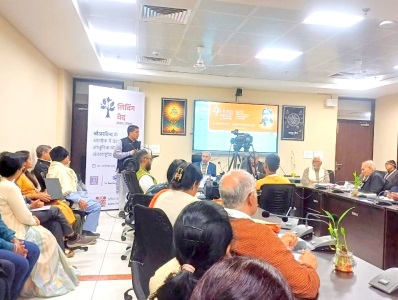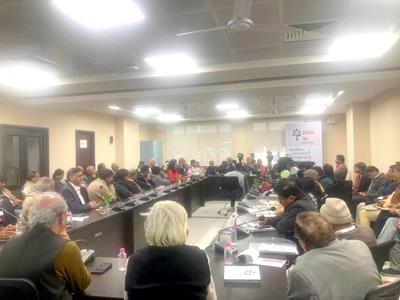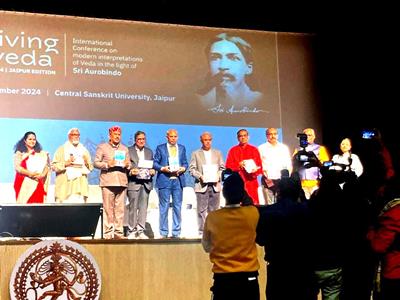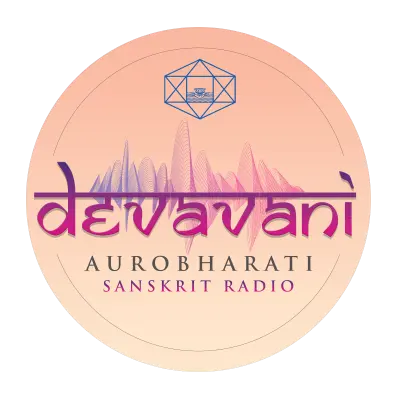Living Veda - Jaipur Edition- Conference on modern interpretations of Veda in the light of Sri Aurobindo
Location: Central Sanskrit University, Jaipur Campus, Rajasthan
Institute: AuroBharati
 The international conference ‘Living Veda-Modern Interpretations of the Veda in the Light of Sri Aurobindo’ (Jaipur edition) was jointly organized by Sri Aurobindo Society, SAKSHI Trust and Centrel Sanskrit University at Jaipur on 28th-29th Dec, 2024.
The international conference ‘Living Veda-Modern Interpretations of the Veda in the Light of Sri Aurobindo’ (Jaipur edition) was jointly organized by Sri Aurobindo Society, SAKSHI Trust and Centrel Sanskrit University at Jaipur on 28th-29th Dec, 2024.
Dr Kishor Kumar Tripathy, Member Secretary, AuroBharati, Sri Aurobindo Society, Union Territory of Puducherry, attended the conference and presented a paper, ‘Divine Life and the Veda in the Light of Sri Aurobindo: Principles and Practices.’ Dr Tripathy presented that the idea of Divine Life as articulated by Sri Aurobindo introduces a novel viewpoint on spirituality, which seeks to reconcile active engagement with the external environment and profound spiritual introspection. Sri Aurobindo presents that life is a space for the progressive realization of the divine, enabling individuals to broaden their consciousness and overcome their limitations.
 Embracing this philosophy allows for personal transformation and facilitates contributions to the advancement of humanity into a new evolutionary stage. In his writings, Sri Aurobindo delves into a variety of experiences that pertain to the evolution of human consciousness and the ascent of life into a divine realm, while also methodically referencing the Vedas. He posits that the Veda is the foundation of Sanatan Dharma, perceiving it as the latent divinity within Hinduism. His paper highlighted different facets of life as informed by Vedic principles, underscoring the essence of Divine Life, which encompasses the Vedic perspective on life and consciousness, as well as the spiritual purpose of existence. The discussion also highlighted Sri Aurobindo’s notions of Integral Yoga, the evolution of consciousness, the unity of existence, the transformation of nature, and the surrender to the divine, all aimed at achieving a higher and nobler existence.
Embracing this philosophy allows for personal transformation and facilitates contributions to the advancement of humanity into a new evolutionary stage. In his writings, Sri Aurobindo delves into a variety of experiences that pertain to the evolution of human consciousness and the ascent of life into a divine realm, while also methodically referencing the Vedas. He posits that the Veda is the foundation of Sanatan Dharma, perceiving it as the latent divinity within Hinduism. His paper highlighted different facets of life as informed by Vedic principles, underscoring the essence of Divine Life, which encompasses the Vedic perspective on life and consciousness, as well as the spiritual purpose of existence. The discussion also highlighted Sri Aurobindo’s notions of Integral Yoga, the evolution of consciousness, the unity of existence, the transformation of nature, and the surrender to the divine, all aimed at achieving a higher and nobler existence.
Sri Amod Kumar, Chairman, Sri Aurobindo Society State Committee, Rajasthan, Dr. Ajit Sabnis, Chairman, Sri Aurobindo Society State Committee, Karnataka, Dr. R V Jahagirdar, Managing Trustee, SAKSHI Trust, Bengaluru, Prof. Vasudev Devnani, Honorable Speaker of Legislative Assembly of Rajasthan, Prof. Makarand R. Paranjape, Former Professor, JNU, Prof. Shrinivasa Varakhedi, Vice-Chancellor, Central Sanskrit University, New Delhi, Dr. Alok Pandey, Resident Doctor, Sri Aurobindo Ashram, Puducherry, Prof. Sudarsan Sarma,
 Director and Secretary, Sri Ashok Singhal Vedic Research Institute, Gurugram, Prof. Sudesh Kumar Sharma, Director, Central Sanskrit University – Jaipur Campus and Prof. Anuradha Choudry, Sanskrit Scholor and Coordinator for the IKS graced the occasion.
Director and Secretary, Sri Ashok Singhal Vedic Research Institute, Gurugram, Prof. Sudesh Kumar Sharma, Director, Central Sanskrit University – Jaipur Campus and Prof. Anuradha Choudry, Sanskrit Scholor and Coordinator for the IKS graced the occasion.
The conference addressed on all recent approaches and interpretations of the Veda. Its bedrock is the belief, after Sri Aurobindo that in the Veda alone is a combination of knowledge, words, and works; here, the mantra is the thing itself. Our concern in this conference is not whether the Veda will be upheld as the supreme Hindu scripture. Instead, it is with the more fundamental question of the meaning of the Vedas, with the “secret” they contain, and with the relevance of that secret to our lives and times. That is why our inclination is toward Sri Aurobindo, who wrote his brilliant and gripping exegesis called The Secret of the Veda.



